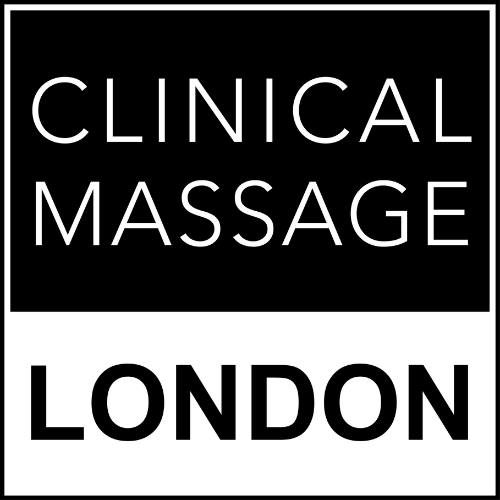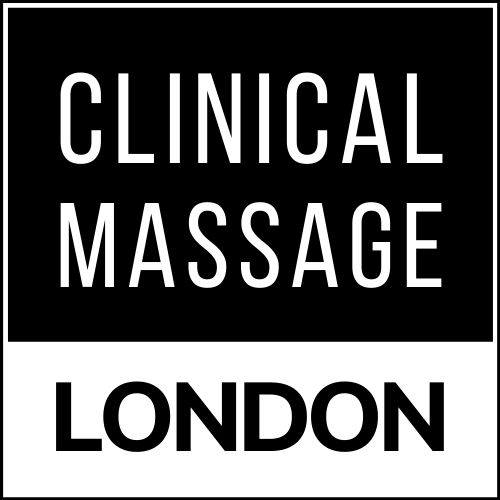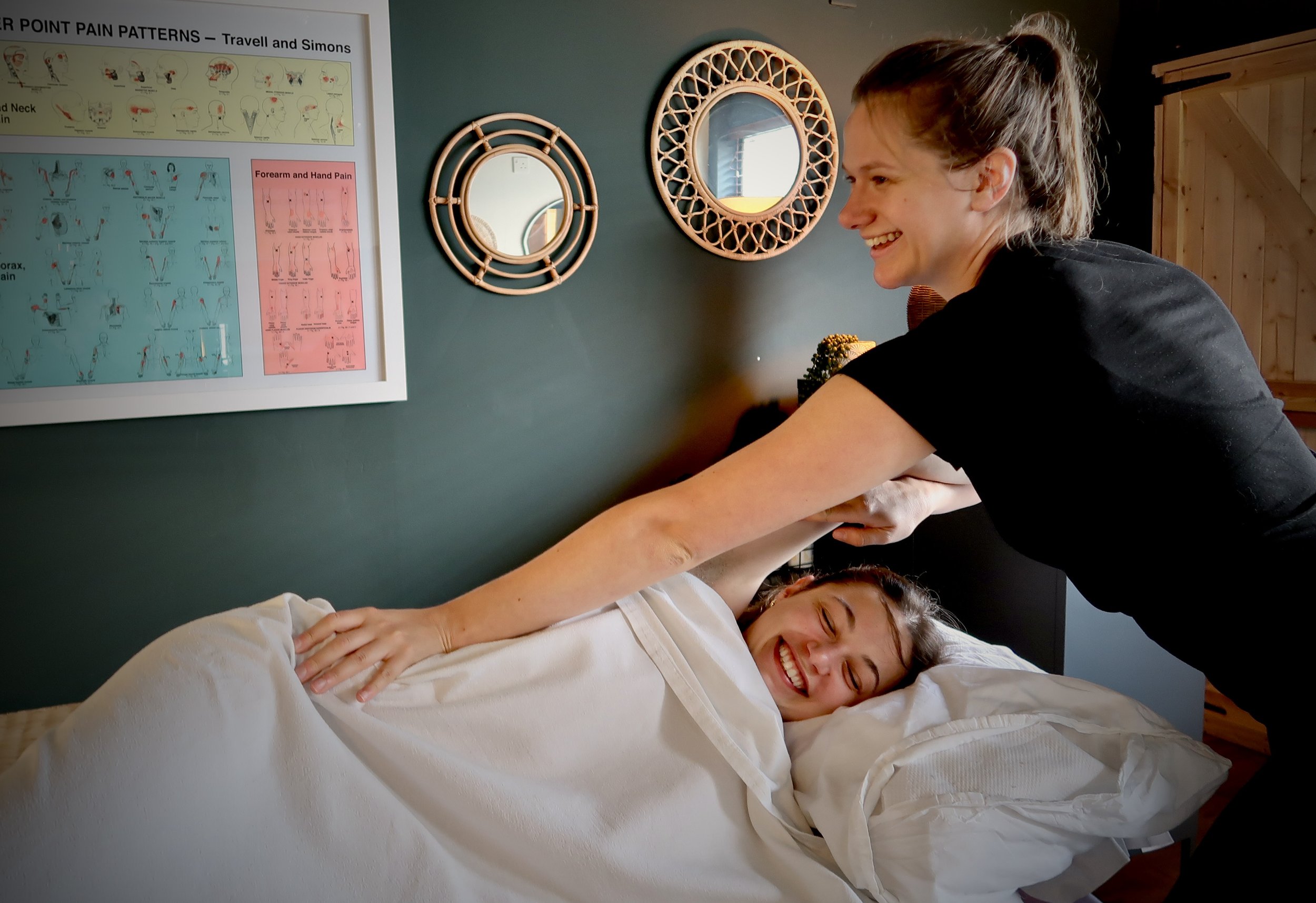Meet Diane Croskin
Genetics to pole dance to pain science – Diane Croskin’s journey to massage is unlike any other.
Q & A With Our New Massage Therapist Diane Croskin
This month, we’re excited to introduce Diane Croskin, the newest member of our team here at Clinical Massage London! Diane brings a unique blend of experience as a clinical soft tissue therapist and a newly qualified physiotherapist. In this Q&A, she opens up about what drew her to the field, how personal injury shaped her career path, and how her recent MSc in Physiotherapy is deepening her holistic, hands-on approach.
Overcoming Injury – The Path to Massage & Physiotherapy
Diane Croskin talks about how a back injury that stemmed in part from years of flexibility training as a pole dancing instructor set her on the path to pain science, soft tissue and physiotherapy.
After an undergraduate degree in Genetics, and then exploring your passion for the human body and movement as a pole dancing teacher, in 2020 you decided to find further ways to work directly with people. What made you choose to do that through a Diploma in Sports Massage and Remedial Soft Tissue Therapy?
It was actually interesting because it was my own injury that inspired the movement in this direction.
Pole dancing can involve a very high level of flexibility training - it doesn't have to, but it can. And that's certainly the direction I took. I was doing almost contortion levels of flexibility training for my back. I had a very flexible lumbar spine area anyway, and I found it very hard to open the thoracic area of my spine. So all my flexibility training was dumped into the lumbar spine when I was doing all of these moves. And, over time, I think that definitely took its toll. I started to get periods of intermittent back pain, which could be quite severe. And, of course when I was doing this, I was a young 20 something and maybe didn't pay quite as much attention to it as I should have done.
When I stopped teaching, I went traveling for a while, and when I got back I started working a job in management. At work, I hurt myself doing this classic lift and twist movement, which led to some very severe back pain. I went to see someone about it and was told I had a herniated disc.
And it was that process of seeing a physiotherapist and putting all of those things together - the things that can lead up to disc injury and then experiencing recovery and how helpful seeing a physio was for my recovery that inspired me. I went from being able to easily lift my own body weight upside down to barely being able to hold a plank on my knees. The woman I worked with really really helped me, she helped me to regain confidence in my body.
I wasn't sure if becoming a physio directly was going to be right for me, but I was certainly inspired. Management wasn't doing it for me, and I really, really wanted to work directly with people again, so I decided to do my Level 5 Remedial and Sports Massage diploma.
So I would say my own injury and the process of recovery and how physio helped me through that was really impactful in terms of my choosing to follow through this career and my desire to help other people with injuries of all kinds - especially conditions or injuries where pain perception can become an important or very important part of people's recovery.
Integrating Soft Tissue Therapy and Physiotherapy
Diane Croskin working on a the triceps of a client at our Clinical Massage London treatment space in N16, North London.
You've mentioned being able to help people recover from injury or work through pain has been incredibly rewarding, are there any particular instances or case studies that really stand out for you?
I remember seeing a client who had been having tingling and numbness in one of his arms. This person was a musician who plays a lot of different instruments. They also were doing a lot of work on their computer. So a lot of input was going through the dominant arm. At this point I'm thinking this might not be appropriate for me to work with (due to nerve involvement), but let's do an assessment.
The pattern of tingling matched up with an ulnar nerve distribution (which is unlikely to be due to nerve root issues and therefore appropriate for a L5 therapist) so I checked through the points where the ulnar nerve runs and found a lot of compression around the medial elbow which I was able to work through. So for this client, it was muscular compression from all of their hobbies, all of the things that they love doing that was causing these symptoms that they were experiencing. And I was able to make a massive reduction in that with just one session.
So then it was - okay, we want you to be able to do your hobbies and your career and these things that you love. So what are some ways we can change what you're doing? So that was a collaborative conversation - talking about hand hygiene for musicians, hand warm ups beforehand, stretching afterwards, all of these things that we maybe don't think about. That was a very interesting case for me and a very interesting person to work with, and just to make that difference in someone's life was very rewarding.
I mean, there are so many cases I can think of. I remember the first time I met another person that I worked with, they were hobbling up some steps towards me when we first met and had very bad hip pain. The causes of that were quite multifactorial and something we had to work on over quite a long period of time. And that did include stressful factors within their life as well as physical and biomechanical factors. So that was very rewarding to work with them to get to a place where they weren't experiencing pain anymore, and just to say, ‘Hey, you can walk up the steps towards me now, and there's no limping anymore!'
Understanding Pain Science: How Education and the Nervous System Influence Chronic Pain Recovery
Massage Therapist at Clinical Massage London Diane Croskin feels that understanding pain is often the turning point—not just for physical recovery, but for restoring confidence in the body.
You mentioned an interest in Pain Science, and a desire to attend future courses with pain science experts like Lorimer Moseley. What got you interested in pain science, and is pain science education an important part of treatment? What are the challenges of untangling and or integrating this knowledge when helping people make sense of their pain experiences?
Well, going back to my back injury, what was interesting is even though the initial pain had gone and I'd done well in terms of my initial recovery, I still had this lingering pain in my lumbar back, which would just come occasionally, but could be quite severe. I would get spasms through it which could be quite distressing.
I spoke with one of the tutors on the course of my (Remedial and Sports Massage) diploma and told him you know, I'm experiencing this, and I don't know what to do.
He was the first person who got me really interested in pain science because he explained to me about the nervous system's involvement and how that protective response continues even after the injury, especially with longer term conditions. So that became a very interesting process for me. Firsthand working with my body and with my mind to try and integrate that sense of safety essentially. Like, oh, okay. My back is safe now. I have healed from the initial injury, and now I have to work on my nervous system.
So I remember specifically, an incident where my back went into spasm when I was reaching for an item on a high shelf at a supermarket. And I became very stressed about this. And, that made it much, much worse. When I reflected on that incident with this new knowledge that I had, I thought, ah, yes, how I think and feel about this (previous) injury has a very direct impact on my current experience of that part of my body and how bad it can feel physically. And that was really fascinating.
In terms of the challenges of untangling and or integrating this knowledge when helping people make sense of their pain experiences - it depends obviously what the patient has come to see you for.
In cases where pain has been ongoing for some time or is more persistent, education about pain and how it works is a very important part of treatment. Understanding what is happening in the body really helps people to begin to manage their condition and makes, I think, such a change on how they view things. And research shows that as well.
So I think it's very important. Say if someone's had a back spasm, maybe their backs have gone into a bit of a protective response, it's very important and helpful for people to understand - why is my body doing this? Why do I have pain here? Like, okay, my body is trying to protect me - and that's helpful, but not always. So just understanding why these things are happening gives people some agency and control.
And with persistent or ongoing pain that sense of understanding becomes so so important. There is so much agency that we gain when we understand how our brains decide how much pain we experience, and the knowledge that we can have an impact on that. That's massive.
I think one of the challenges of working in this area is that a lot of people who experience ongoing pain haven't always been believed in the past, and these ideas and research about how pain works are still relatively new. So it's very important that health care professionals share this information with people using a sensitive approach, and give space for people to share their pain experiences in a safe space.
Our newest therapist Diane Croskin is here with a fresh perspective, serious skills, and a passion for helping people move and feel better at our treatment space on Stoke Newington Road.
How an MSc in Physiotherapy Deepened Diane’s Approach to Pain, Injury, and the Biopsychosocial Model
Diane Croskin believes in client-centred care.
You recently completed a pre-registration MSc in Physiotherapy. What led you to take your training further in that direction, and how has doing the masters informed your practice as a soft tissue therapist?
I’d been working as a soft tissue therapist for a while, but I found myself craving more challenge and depth. I wanted to work more specifically with injury and pain, and the master's offered a structured path to build clinical reasoning and deepen my understanding. It’s given me a richer framework—especially through the biopsychosocial model of health and pain science. We looked at the full picture of health: psychological stress, social context, beliefs, and how these all interact with physical symptoms.
I’ve become more curious about clients' wider lives—asking not just what hurts, but what’s going on for them. That helps shape treatment and guidance in a more meaningful, tailored way.
So I had completed my diploma, and I'd been working in the field for some time. I think maybe where I was working at the time wasn’t the right place for my skills to be challenged in the way that I wanted.I was doing what I would say were very general treatments, whereas what I wanted to be doing was working a bit more specifically with people in pain, in a setting that provided space to address the multifactorial nature of pain.
I think that’s one of the things that prompted me to sign up for my masters. I've always been a person who wants to challenge themselves to learn more - the master's offered a structured path to build clinical reasoning and deepen my understanding.
I think the question about how the masters has informed my practice as a soft tissue therapist is really interesting.…
The fields definitely have their similarities. Both involve working with people and their bodies, and all the factors that impact that. I would actually say one of the bigger things that came from my masters was that there was a lot of focus on the biopsychosocial model of health. So, looking at all the different factors that can impact health, rather than just the physical factors. And there was also a large focus on pain science.
So my masters really helped me to develop in those areas and helped me to gain more understanding of how to take that model and apply it to the people that I see and to my practice as a soft tissue therapist. To say, okay, what are the lifestyle factors that this person has? For instance, do they worry about a parent who has a similar condition? Are they very stressed at work? How is this going to impact how they see their condition and their recovery? Healthcare is starting to move in this direction so it's important to take these things into account and think about how they can be integrated into treatment.
Balancing Hands-On Therapy and Rehabilitation
Therapist Diane Croskin performing deep tissue massage on a client at our treatment space in North London.
What are your thoughts on the importance of hands-on work and rehabilitation, and how do we find a balance on knowing how and when clients can benefit from either or a bit of both?
I think this is a very broad and interesting question. Physio, how it's taught in university and certainly how it's currently practiced in the NHS, can be not quite so focused, or really entirely not focused on hands-on work. And that is because of the amount of evidence that there is for exercise. And also there is this understanding or thought that patients need to take the onus of their own condition onto themselves, and therefore not have that potential reliance on a healthcare professional that is thought can develop with solely hands-on work.
So it is an interesting one. I don't fully follow that line of thought, but it was something that was hammered in relatively hard during my physio masters, which was interesting coming from the background that I do. I will say that's not what we're taught at level five, level six (remedial and sports massage) diploma level - there is that teaching that we're helping people with something and that you can work in ways which empower clients to take control of their own health and health conditions. But, I do always remember one of my tutors saying you can't massage strength into the body.
So I think it is important to definitely have a balance between those things. And, again, it's very variable. It depends what the individual person is coming to you with.
Say if the issue is compression because this person, I don't know, always sits a certain way or, they have a previous injury and they've altered their biomechanics to protect it, and now they have compensation patterns that are due to that. You're going to have a whole bunch of trigger points. So then hands-on work is very important to help relieve that, and then we can start looking at rebalancing everything else.
So I think it's helpful to have a mix of these things. And again, it depends. Certainly if someone sprained their ankle a few weeks ago, then a little bit of hands-on work will be helpful for the inevitable compensation patterns. But, we need to be following a rehabilitation program to strengthen their muscles so they can support the ankle while that healing process is going on for the ligament.
I think there always will be a bit of debate on this, and again, it really depends what the condition is - there isn’t a one size fits all answer for this question.
Plans: Specialising in MSK & Gaining NHS Physiotherapy Experience
Diane Croskin consulting a client about their treatment goals at Clinical Massage London in Dalston.
What are your future plans in terms of continuing training and education within Physiotherapy - do you have any plans to specialise in MSK / a particular track of physiotherapy/ look into work experience in the NHS / finding mentorships and eventually starting your own physio practice?
My plans are to continue my soft tissue therapy work, making use of all that knowledge from the two quite intensive years of my physiotherapy degree to inform my current practice. I've organised shadowing with an MSK (musculoskeletal) physiotherapist, which is the area that I'm most interested in. I did very much enjoy respiratory physiotherapy while I was at university, and I do still enjoy working on breathing patterns and disordered breathing issues with people. However, MSK is my main area of focus.
I want to continue my current work, and at the same time gain physiotherapy experience with these mentorships and shadowing processes. So, those are the plans at the moment. I'm really excited for this new stage of my career.
Meet Diane Croskin, our newest therapist at Clinical Massage London in Dalston.













